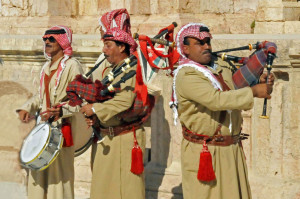People have lived near Jerash for more than 6,500 years, but the city remained small until it was conquered by the Roman Empire in 63 B.C. and joined the Decapolis, the league of cities mentioned in the Bible. Known as “Gerasa,” the city prospered from trade with Petra and began building temples, baths and theaters. When Emperor Hadrian visited in 129 A.D., Gerasa erected a three-opening arch in his honor and began a golden age of prosperity. Eventually, the city encompassed 200 acres, with a population of about 20,000. When Christianity became legal in the fourth century, Gerasa residents defaced the temples and built churches.
After Persia conquered Gerasa in 614, the city began a slow decline. In 749, Gerasa was virtually destroyed by an earthquake and the ruins were eventually buried under blowing sands and forgotten. When the ruins were rediscovered in 1806, the building materials had not been looted as in other ancient cities, allowing reconstruction of structures from the recovered rubble. Today, after almost 100 years of continuous effort, Hadrian’s arch, temples to Zeus and Artemis, two theaters, public baths and fountains, markets and a hippodrome have been at least partially restored. The half-mile-ling cardo ends at an unusual 90-meter long paved oval surrounded by Ionic columns, whose original purpose is still uncertain.
Each July or August, entertainers from around the world celebrate their cultural connections with ancient Rome in the restored southern theater during the Jerash Festival of Culture and Arts. Every day, robed Jordanians in red keffiyehs serenade visitors to the southern theater with bagpipes. Surprising to many, bagpipes are authentically Roman. Early writings describe Nero playing the tibia utricularis, its pipes probably sewn to the leg and head openings of a sheep skin. The Scots borrowed the idea from invading Roman soldiers. Where the keffiyehs came from is a different story.

Comments are closed.